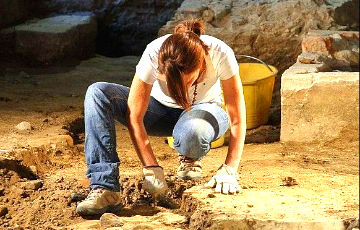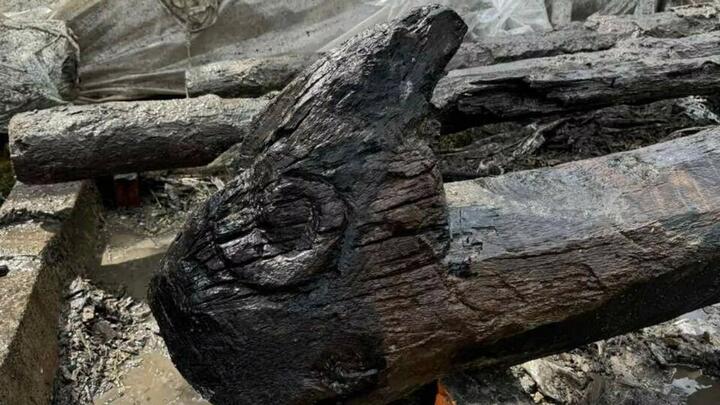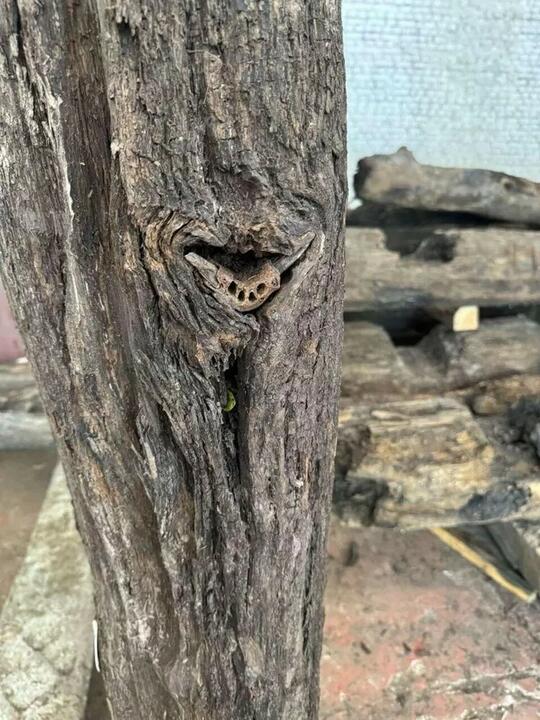Archaeologists: Brest Region Could Have Been Inhabited 400 Thousand Years Ago
8- 3.01.2025, 11:21
- 4,526

And Minsk was “guarded” by a boar's jaw.
Belarusian archaeologists have uncovered the secrets of the ancient Minsk settlement — they found the remains of a settlement that is “two to three thousand years old”. A wooden ladle was found — the same age as the Egyptian pyramids, the oldest cemetery in our country was discovered on the island of Lake Selyava, and Neanderthals or even their ancestors could have lived in the Ivanovo district about 400 thousand years ago.
Minsk was guarded by a figure with a “beak” and part of a boar

The largest scientific project of recent years has been the study of the archaeological complex on the Mienka River. Archaeologists were able to uncover the structure of a 10th-century rampart — nothing like this has survived in Kyiv or Novgorod. In the process of clearing part of the wooden cages, specialists discovered a zoomorphic figure.
In such a specific way, the rampart builders decorated one of the wooden hooks, which was supposed to maintain the balance of the entire structure of the cages.
Andrei Vaitsekhovich, Head of the Department of Archaeology of the Middle Ages and Modern Times of the Institute of History of the National Academy of Sciences, believes that this is due to the pagan ideas about the world of the Dregovichi, who erected huge defensive structures.
During the conservation of wooden structures from the 10th century, a boar's jaw was found in one of the oaks. Such finds had not been made in Belarus before. Soviet historian Boris Rybakov associated such practices with the pagan rituals of the Slavs.

Andrei Vaitsekhovich said that similar finds were made by Polish archaeologists during the study of the Gniezno settlement, where a layer from the reign of Mieszko I was discovered.
It is interesting that the wooden structures themselves on Mienka have a certain similarity with those found during the study of Gniezno. Belarusian archaeologists believe that ancient Minsk is an example of the synthesis of Western and Eastern Slavic technologies.
The First Church of Minsk
Last year, burials of people were found in one of the excavations on the territory of the settlement on the Mienka. Archaeologists have established that they date back to the 11th-12th centuries. An ancient churchyard could have appeared in the city only if there was a church there — it was not customary for pagan ancestors to arrange cemeteries in settlements. Therefore, scientists came to the conclusion that this is an early Christian cemetery, and the temple itself could have stood next to the entrance to Minsk.
In the High Middle Ages, only a status burial could have been located directly next to the walls of the temple inside the city. All this suggests that representatives of the elite were buried here.

A ladle as old as Cheops
Head of the Department of Archaeology of Primitive Society of the Institute of History, Maksim Charniauski, has been conducting expeditions to the Krivinsky peat bog for the past few years — peat allows things, for example, made of wood, to be preserved. Among the finds this year were items made of bone, amber and even bast ropes.
Wooden artifacts were a real sensation. Scientists managed to find a wooden arrow with a blunt tip - these were used for hunting fur animals so as not to spoil the fur.
The main discovery of this field season was a wooden ladle the size of a human palm. There is an assumption that its handle is stylized as a duck's head.
“These are all materials of the northern Belarusian culture, the second half of the third millennium BC — the beginning of the second millennium,” said Maksim Charniauski.
The oldest cemetery is on a lake island
An island on Lake Selyava is a find for the study of Mesolithic monuments. Recently, Aliaksandr Vashanau, a research fellow at the Department of Archaeology of Primitive Society of the Institute of History, managed to find an archaeological site there with artifacts from the 10th-7th millennia BC. Kunda culture and the early Neolithic of the 6th millennium BC Narva culture.
In 2019, there was a scientific project in Belarus to study ancient human DNA. As part of its implementation, it was possible to date three burials from a settlement on an island on Lake Selyava.
“We did a DNA analysis: one of the skeletons dates back to the early Iron Age (Dniapro-Dzvina culture). One belonged to the late Neolithic (Corded Ware culture) and another burial belongs to the Kunda culture. Today we can say that this is the most ancient burial on the territory of Belarus. We do not have earlier human remains,” said Aliaksandr Vashanau.
Brest region could have been populated half a million years ago
At school, we were all told about the glacier that sometimes came to the territory of Belarus, sometimes went away. The textbooks say that the most ancient sites of primitive people in the country are in Berdyzh and Yuravichy — they are more than 20 thousand years old.
However, in the Ivanava district near the village of Ohava there is a sand quarry, where local historian Yury Seliazniou collected a whole collection of flint and assumed that among it there are also ancient tools.
Archaeologists from the Institute of History headed by research fellow Aliaksandr Vashanau went to the site. During the excavations, a cultural layer with artifacts was found. Russian scientists helped to interpret the finds. Geologists concluded that the finds from Ohava are not younger than 400 thousand years and may be older. This allows us to assume that these tools were used by Neanderthals or Heidelberg man.
Belarusian archaeologists believe that there may be other similar places in the Brest region. Now the finds from Ohava allow us to make our history 20 times more ancient than Berdyzh and Yuravichy.











